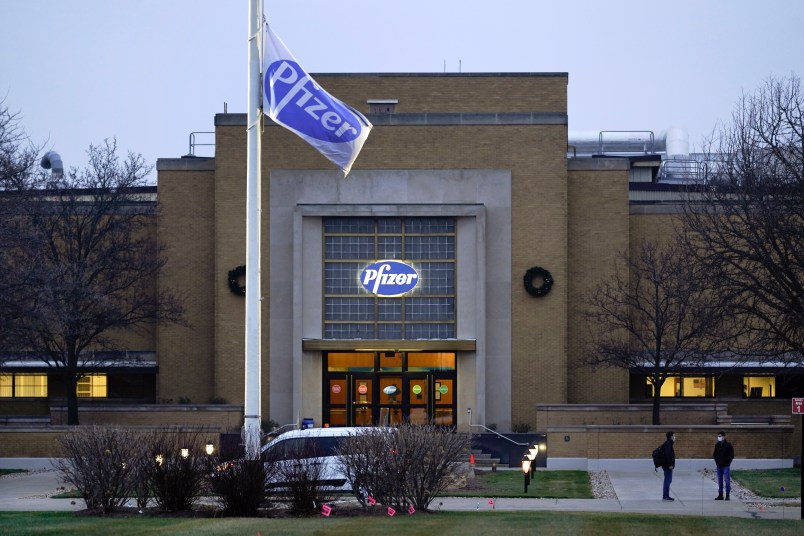More than a dozen states are now reporting that the feds slashed their COVID-19 vaccine allocation, leading to questions over the Trump administration’s planning for the distribution effort.
Experts in vaccination and medical supply chains whom TPM contacted expressed dismay and confusion at the situation.
States from California to Maine have said that their vaccine allocations have been cut while Pfizer, the manufacturer, has said that it has “millions more doses sitting in our warehouse but, as of now, we have not received any shipment instructions for additional doses.”
To Bruce Y. Lee, a professor of health policy at CUNY who helped model the rollout of the H1N1 vaccine, it suggests a logistical issue.
“When vaccines get produced and they remain in the warehouse, that means something went wrong with the supply chain,” Lee said. “That it was not coordinated.”
He added that the cut in vaccine shipments, in some cases by 30 percent and some cases by far more, comes amid concerns about “what is the plan with the supply chain and delivery system, and that hasn’t been very clear.”
Operation Warp Speed and CDC officials informed states of the reduction in vaccine shipments on a call on Wednesday, blaming the issue on manufacturing issues at Pfizer. HHS Secretary Alex Azar did the same in an interview Thursday morning.
Pfizer has denied that, saying that it has yet to receive orders on where to send the doses that it has.
“It’s very difficult to plan when you don’t have any idea what you’re getting, or you have an idea that’s off,” Claire Hannan, director of the Immunization Action Coalition, told TPM.
Mark Capofari, a former director of global logistics at Merck, said that the supply chain for an effort like national vaccine distribution was extremely complex, and added that it wasn’t clear whether the Trump administration had “overcommitt[ed] to how many patients they can fully inoculate from the start.”
The Trump administration has tried to account for the problem by telling the states that they are merely incorrect. According to an HHS spokesperson’s statement to TPM, “Operation Warp Speed allocation numbers locked in with states have not been changed or adjusted.”
The spokesperson added that Operation Warp Speed provides official allocation numbers to the states for the week ahead, and that any other numbers should not be relied on.
But Hannan said that HHS was effectively defining down the “official” allocation number to the final amount in the shipment queue hours before doses arrive.
“I think it’s really tough to then hear HHS come out and say that’s incorrect, that their allocations weren’t cut,” Hannan said. “And then hear them say that that’s a planning estimate, and don’t count on it until it’s actually in the queue to order.”
“If we do that, if we wait until something is in the queue to order, then there’s no planning at all,” Hannan added, saying that it significantly reduces the amount of time states have to plan to distribute the dose allocations that they receive.
The logistical issues are compounded by ongoing lack of federal funding or support for those actually injecting the vaccine at the state and local level.
The mystery of where the vaccine doses have gone, and why they haven’t been shipped out, remains. Operation Warp Speed is working with FedEx and UPS to distribute the Pfizer doses; neither company provided an explanation for what may be happening.
FedEx referred TPM to the government, and said that it’s working “to transport the vaccines as directed by their allocation and distribution plans. It isn’t up to us to decide who gets the vaccines.”
UPS said that three vaccine packages on Thursday were delayed, but were expected to be delivered by the end of day.
HHS Assistant Secretary for Health Adm. Brett Giroir said in a statement on Friday that the government was withholding doses for the second dose of the two-shot vaccines.
No one is letting #CovidVaccines sit in a warehouse! We need to reserve doses for the 2.9 million being vaccinated this week to ASSURE they have supply in 21 days. There is also 500k emergency reserve. Expect 7.9 million vaccines shipped next weeks (Pfizer and Moderna).
— ADM Brett P. Giroir (@HHS_ASH) December 18, 2020
Hannan said that Giroir’s numbers would only account for part, but not all, of the doses being withheld.
“Mathematically, there are more doses that need to be accounted for,” Hannan said. Operation Warp Speed has committed to deliver 20 million doses by 2021.
“If they’re holding doses, then how did they come up with that specific number? And how does that jibe with the production schedule?” Lee asked.
Lee added that it was unclear to him why the Trump administration would coordinate second-dosing at the national level after delegating the rest of local distribution policy to state and local officials.
“You can’t have it both ways: if you’re going to coordinate when people come back for the second shot from the national level, then you need to decide how you’re going to distribute from the national level,” he added.










